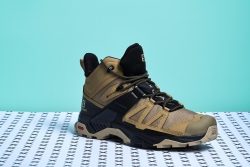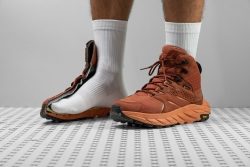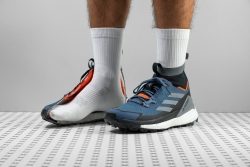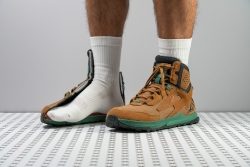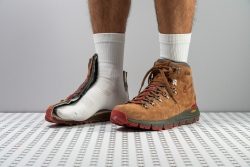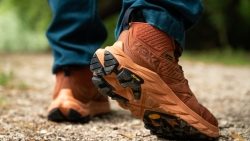7 Best Hiking Boots in 2024
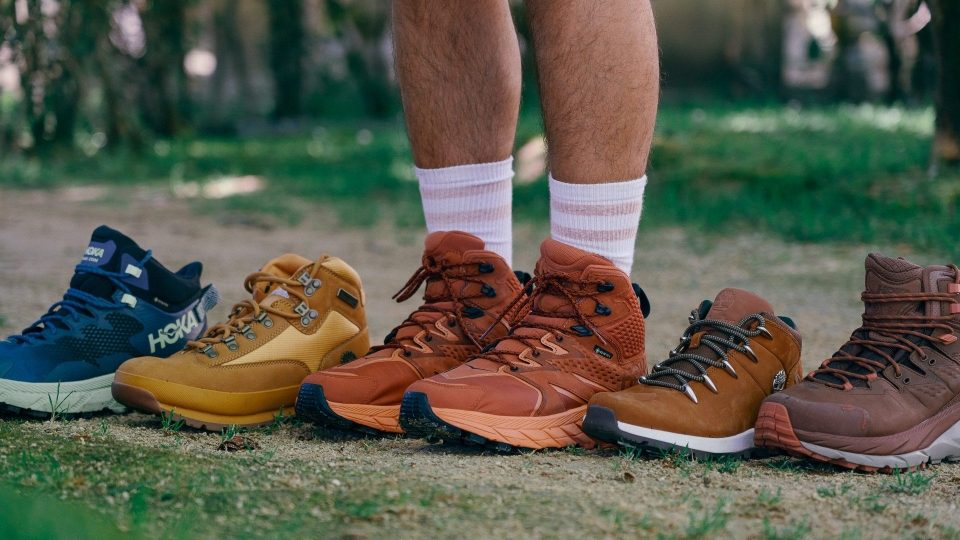
Confused about what to buy after seeing the hundreds of boots available online? Well, worry not. Whether you’re a beginner hiker planning to go on a nature walk or an experienced backpacker looking for a new pair of kicks, we are here to help make your boot-hunting experience a breeze with our list of best hiking boots and detailed guide.
Having tested hiking boots on the mountains and in the lab, we know what makes the best one. Whether you’re looking for a heavy-duty trailblazer or a lighter option for some speedy hikes, we have selected our top picks in different categories.
How we test hiking boots
We, at RunRepeat, help boot shoppers find the right hiking boot without going through the hassle of checking out every feature of every boot in numerous brands. When it comes to providing thorough reviews, we offer a complete, one-stop guide! Here’s a quick overview of what we do:
- We pick up all the hiking boots using our own private money, with no one capitalising on us.
- We backpack and trek for hours in different terrains and elevations while in the hiking boots, personally determining their level of grip, durability, stability, and others.
- We take the boots back to our lab to test and analyse them to a data-driven extent.
Best hiking boots overall














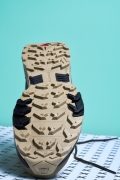





What makes it the best?
For a hiking boot that does the job come rain or shine, look no further than the Salomon X Ultra 4 Mid GTX. It can handle torrential rain and mud, and it’s still an extremely lightweight boot suitable for longer, drier days on the hill. In short, the Salomon X Ultra 4 Mid GTX is hands down our best overall hiking boot.
On our wet and rainy hikes, we tested the boots in a deep puddle to test the waterproofing. Incredibly, despite standing in water for over a minute, there wasn’t even the slightest seepage. On closer inspection in the lab, we saw that the tightly woven upper and Gore-Tex membrane are complemented by a fully gusseted tongue and high collar. That explains why no water could get in!
Even with all that protection from the elements, these boots are far from clunky. We weighed them at 14.5 oz (412g), which is astounding, given that the average for waterproof boots is 19.5 oz (553g)! We found this ideal for our longer day hikes and multi-day adventures because our feet tired much slower than expected.
We found the X Ultra 4 Mid GTX to exhibit superb traction whether we were hiking on dry and dusty trails or on wet rock. We inspected the Contragrip outsole in the lab and counted 41 lugs which measure 5.1 mm deep. 0.7 mm above average isn’t much, but it worked wonders for us on any terrain. We especially like the chunky heel lug which gave us extra braking power or steep, loose descents.
The mid-height ankle support of this boot may not be enough for hikers with weak ankles. We can recommend https://runrepeat.com/uk/salomon-quest-4-gtx the Salomon Quest 4 GTX for a more protective alternative.
Pros
- The boot of choice for multi-day hikes
- Lightweight
- Waterproof
- Excellent grip
- Supportive midsole
- Detailed ground feel
- Great ankle support
- Protective
- Perfect lacing system
Cons
- Midsole may be thin for some
- Very stiff in colder climates
Hiking boots with the best cushioning










































What makes it the best?
After being subjected to meticulous testing in our lab and long day hikes, we have to say that the hiking boot with the best cushioning is doubtless the Hoka Anacapa Mid GTX. With its iconic Hubble heel making our landings cushy, its feather weight and impeccable support really make it stand out from the crowd.
Hoka’s protruding heel acts as a shock absorber and makes for super-smooth transitions. Our measurements of the stack height at the heel and toe showed it has plenty of material underfoot - 36.7 mm at the heel and 26.1 mm at the forefoot. While the heel stack is a minimal 0.5 mm higher than average, the forefoot is 2.3 mm higher than average. We appreciated the resulting 10.6 mm drop on sustained descents, as it took the pressure off the forefoot.
Our feet felt snug and comfortable from the get-go. We put the luxurious cushioning under our feet to the test in the lab. Perhaps unsurprisingly, we found it to be much softer than average. Our durometer test of the EVA midsole showed 22.5 HA, far softer than the average of 29 HA. On the trails, we felt protected from the ground beneath and we experienced all-day comfort for our feet.
Despite sporting such a soft midsole, the Hoka Anacapa Mid GTX rates 5/5 for torsional flexibility in our lab tests. 5 being the stiffest rating, it’s pretty hard to twist an ankle while wearing these boots! We felt really stable when hiking on rocky, uneven trails, and light scrambling was a breeze.
When we pumped smoke into the boot to test for breathability, we had to award this boot 1/5, the least breathable rating. The Gore-Tex lining doesn’t allow air to flow into the boot, making it very hot. We don’t recommend the Hoka Anacapa Mid GTX to hikers looking for a fresh-feeling, breathable summer boot.
Pros
- Top-notch waterproofing
- Very lightweight
- Generous and soft cushioning
- Reliable stability (with a light backpack)
- Wide platform
- Flexible forefoot
- Excellent grip
- Doesn't get too firm or stiff in cold
- Comfortable in-shoe feel
- Effective lacing system
- Sustainable materials
Cons
- Not supportive with heavy backpacks
- Upper lacks wear resistance
- Extended heel catches rocks and roots
- Not for wide feet
- Tricky to put on
Best hiking boots for backpacking
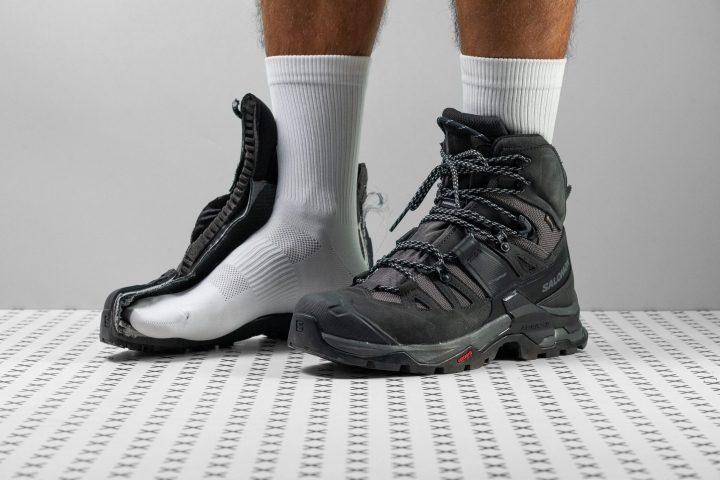












































What makes it the best?
On our hunt for the best hiking boot for backpacking, our research led us to the Salomon Quest 4 GTX. Exceptionally supportive, incredibly durable, and protectively cushioned, it’s the perfect companion for multi-day hikes over rough and rocky terrain.
As soon as we laced up the boot we could feel the support afforded by Salomon’s integrated ADV-C 4D chassis stabilizer. In the lab, we twisted and bent the boot, finally awarding it 5/5 for rigidity - the most rigid possible. Even when rock hopping on alpine trails with a heavy pack, we couldn’t twist an ankle if we tried!
If we could, we would give the Salomon Quest 4 GTX a 10/5 for durability! We applied our Dremel liberally to the toe box, the heel, and the outsole – all three far exceeded our expectations! After 12 seconds at 5K RPM at a force of 3.2N, the solid rubber toe cap barely showed a scratch. While hiking on rocky trails or light scrambling, we could relax, knowing our toes are fully protected from bumps and scrapes.
The midsole is of average firmness - 27 HA according to our durometer measurements. The stack height at the heel is 2 mm above average, meaning there is plenty of firm material underfoot to protect our heels from sharp rocks. Heel strikers in particular may enjoy the extra material below the heel.
While 23.4 oz (663g) is not unusual for a highly supportive backpacking boot, for most day hikers, this may be overkill. For this reason, we don’t recommend the Salomon Quest 4 GTX to light hikers or day hikers.
Pros
- Exceptional durability
- Top-notch waterproofing
- Excellent impact protection
- Highly secure ankle support
- Fantastic stability
- Comfortable in-boot feel
- Effective grip on various terrain
- Fits as expected
Cons
- A bit heavy
- Gets very stiff in cold
Best lightweight hiking boots













































What makes it the best?
Following rigorous lab tests and outdoor excursions, the Adidas Terrex Free Hiker 2 emerged as our top lightweight hiking boot. This agile and lightweight marvel offers exceptional traction and luxurious comfort, empowering us to navigate through the wild with full confidence.
This boot rides more like a trail shoe on steroids with its light and natural feel. Weighing a mere 15.0 oz (425g), it outshines competitors by a significant 16.3% margin, providing a nimble feel that allows us to speed up. It feels like a breath of fresh air as the breeze flows liberally through the upper. Our breathability tests reaffirm this with the highest 5/5 rating.
Moreover, its adaptable midsole facilitates unrestricted movement. Our bend test reveals it's 38.6% more flexible than average. Equipped with grippy 3.7 mm multi-directional lugs, this boot excels on both wet and dry surfaces, efficiently shedding mud and debris along the way.
The midsole delivers otherworldly comfort from start to finish and we enjoy a spring in our step while hiking. Using our durometer, we discovered that it’s 39.4% softer than average. With its rockered geometry, the ride feels smooth as we’re being launched forward.
While its £210 price tag reflects its quality, budget-conscious consumers may want to explore alternative options.
Pros
- Extremely well-cushioned
- Luxuriously padded interior
- Grippy and durable lugs
- Tackles wet surfaces confidently
- Very flexible and forgiving
- Excellent airflow
- Feels incredibly stable underfoot
- Supportive heel collar
- Rockered midsole
- Relatively lightweight
- High-quality construction
- Eye-catching design
Cons
- Needs breaking in
- Tricky to put on
- Expensive
Best leather hiking boots
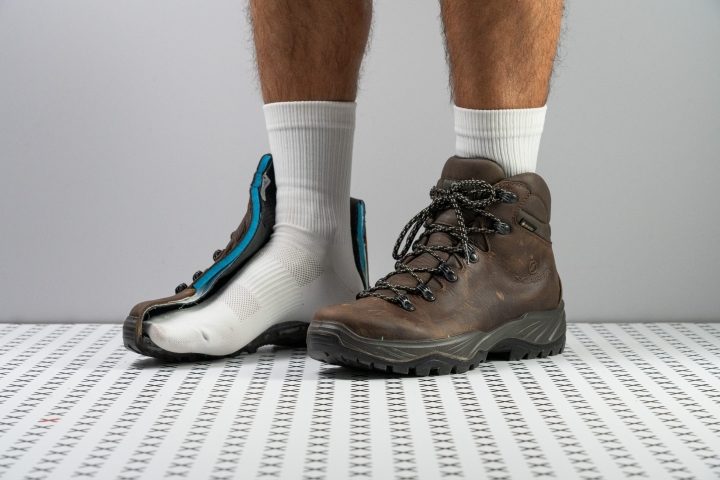







































What makes it the best?
After multiple wear tests and lab analysis, we discovered Scarpa Terra GTX as the best leather hiking boot. It delivers the support and protection we need to traverse rough terrains with its impenetrable upper, stable ride, and impressive adhesion capabilities. Its tank-like build gave us confidence like no other.
Terra GTX kept our feet warm and dry as we sloshed through puddles and streams. In our breathability tests, it blocked off smoke and light completely with its solid leather upper, confirming its insular nature.
Each stride feels surefooted even as we carry heavy backpacks on technical trails. The firm and low-profile platform enhances ground feel and doesn’t compress easily. Our durometer confirms it’s 16.1% harder than average. Providing additional support is the stiff heel that scored 4/5 in our manual assessment. Thankfully, it didn’t place unwanted pressure on our Achilles since it tapers down slightly in the rear area.
Underfoot, is the renowned Vibram outsole that is reliably durable and grippy. It has 4-mm multi-directional lugs that serve as our source of traction and brakes. From loose gravel to slippery mud, Terra GTX powered through them all.
Unfortunately, it’s a heavyweight hiker at 20.3 oz (575g). For long hikes, it felt undeniably chunky and intensified the pull of gravity.
Pros
- Glue-like underfoot, even on wet surfaces
- Insanely comfortable
- Reliably stable and supportive ride
- Resilient and high-quality build
- Durable Vibram outsole
- Watertight and warm
- Quick break-in time
- Performs consistently in the cold
- Strong ankle support
Cons
- Quite heavy
- Cushioning could be better
- Scuff magnet
Best hiking boots with a wide toebox



















































What makes it the best?
Altra’s Lone Peak Hiker 2 is a revelation in our lab, standing out as the best hiking boot for outdoor wanderers with wide feet! Free from cramped toes and hotspots, this lightweight had us with its unparalleled on-foot feel that makes time fly on long hikes.
We loved how it's inclusive of broad feet, giving our toes room to splay and breathe. It barely tapers to the front with its square-toe build, measuring 91.1 mm vs. the 79.2 mm average.
Its malleable and airy build keeps it all natural and light on foot. The ride feels more like a trail shoe, which makes it versatile enough for city walks and light jogs. Our scales show a feathery 12.0 oz (339g), 32.7% lighter than the average hiking boot. Even in our bend test, it proves its adaptive nature as it emerges 24.9% more flexible than its counterparts.
The main reason LPH2 feels so light is its low-to-the-ground profile. It gives high ground sensitivity with its low 2.6 mm drop. Despite this, our feet had enough impact protection and comfort thanks to the buttery platform. Our durometer confirms it’s 12.7% softer than average.
Due to its high flexibility, it inherently feels less stable on rocky terrains. We recommend a more supportive boot for technical trails and backpacking.
Pros
- Exceptionally comfortable
- Astonishingly lightweight
- Gives strides a boost
- Performs consistently in cold conditions
- Superb durability
- Supportive around the ankle
- Excellent attention to detail
- Decent moisture resistance
- Dries quickly
Cons
- Subpar grip on technical terrain
- Underwhelming stability
- Quite hard to put on and off
Hiking boots with the best style












































What makes it the best?
The Danner Mountain 600 concludes our quest for the most stylish hiking boots, boasting a timeless design that seamlessly transitions from the trails to urban environments. Beyond its aesthetic appeal, this boot's construction provides exceptional comfort and protection against unwanted elements, shielding our feet from rain, snow, and debris.
Crafted from quality leather, the Mountain 600's upper acts as a reliable waterproof barrier, keeping feet warm and dry even in wintry and wet conditions. Despite its waterproofing capabilities, the boot surprisingly offers adequate ventilation, earning a commendable 2/5 rating on our breathability test, surpassing typical waterproof shoes.
Beneath the foot, the midsole delivers a comfortable and stable ride, featuring a generous 36.8/23.0 mm stack for cushioned landings. With an average firmness of 24.3 HA, it gives a little pep while ensuring centered and balanced strides. Additionally, its rigid construction effectively minimizes excessive motions and foot fatigue, as confirmed by our bend test, which revealed a slightly stiffer-than-average rating of 42.5N.
However, the outsole's traction fades on wet roots and branches, as we needed additional support from walking poles or nearby trees. We recommend exploring alternative options for more challenging trails to ensure optimal traction and stability.
Pros
- Supportive
- Very comfortable, like a running shoe
- Oustanding grip
- Durable
- Feels light
- Great out of the box
- Waterproof
- Awesome for casual use
Cons
- Debris gets into the boot
- Not for technical hiking
When to go for hiking boots and not shoes
The main anatomical difference between the hiking shoes and boots is the cut: shoes are usually low cut and boots are mid or high cut. Performance wise, that means that the boots offer ankle support thanks to the heel collar that surrounds the ankles and can be tightened with laces.
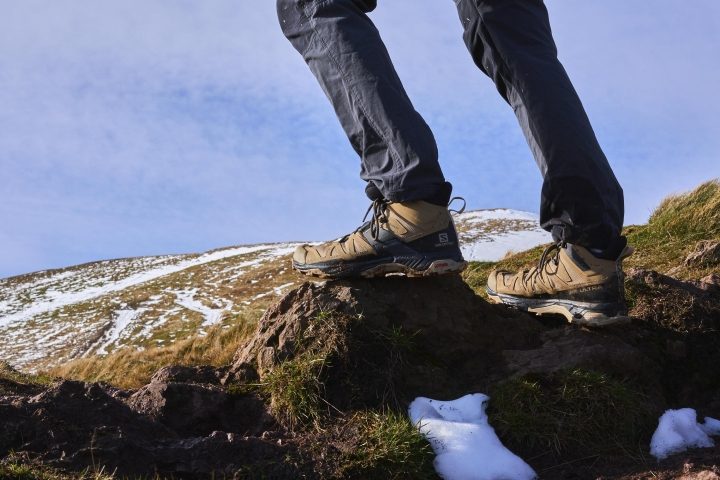
Based on all the tests we’ve performed on our hikes and in our lab, we recommend getting hiking boots when:
- you need ankle support because your ankles are prone to twisting and prefer being secured
- you plan to go backpacking
- you don't like water or debris getting inside of your hiking shoes (and wearing gaiters is not your cup of tea) or if
- the terrain is so harsh you want more protection all over your feet and ankles.
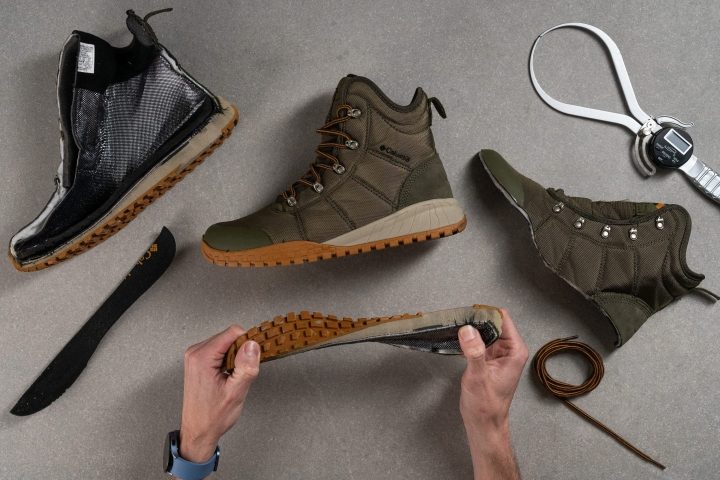
Nail the perfect fit in hiking boots
If you’ve never bought the hiking boots before, these are our guidelines on how to make sure the fit is as good as possible:
- Go hiking boot shopping later in the day, in the afternoon or in the evening. By then, your feet are already somewhat swollen naturally. The swelling happens on the hikes as well so it’s best to match the conditions as much as possible.
- Bring your hiking socks and orthotics (if using) with you and try the boots on with them.
- Lace the boots up and sense if there are any hotspots. Boots should be comfortable and snug, but not too snug or too wide. You should have one thumb’s width of room behind your heel when you push the foot forward. Or, find as much room in front of the toes when your heel is glued to the back.
- Try the boots on the ramp! Go up and down. There should be no heel slipping and no sliding inside the boot.
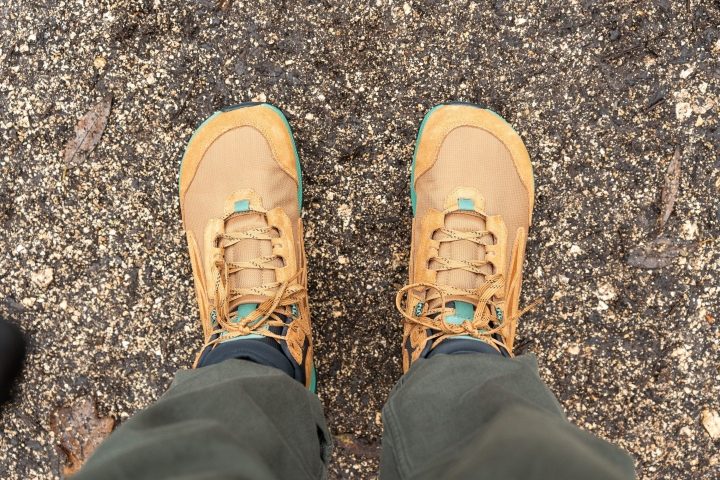
Most boots need some time to be broken in properly. Keep that in mind when planning your hiking adventures.
Hiking boots for beginners and easy hikes
If you’re new to hiking and want to get your first pair of boots, we recommend all-terrain hiking boots that allow for a little bit of everything but are not to be used on very demanding hikes. Very demanding means very long or even multi-day hikes on technical terrain, maybe even with a heavy backpack.
For beginners, we recommend lightweight hiking boots with around-the-average lug depth. That means they should weigh less than 17.6 oz (500g) and have lug depth around 4 mm or less.
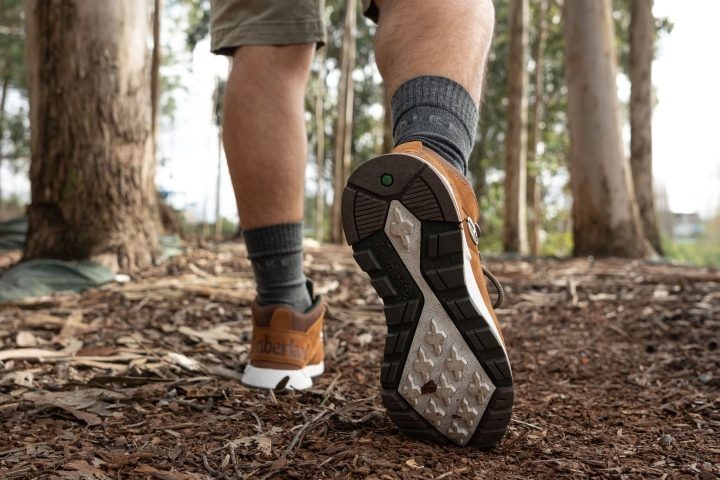
Heavy hiking boots can be too much at first if you’re new to hiking and might tyre your feet sooner rather than later. Very deep lugs work great in soft wet ground but are also less durable. Average lugs (or close to the average) are great for light hikes on usually well-maintained trails.
Another tip for beginners: hiking boots with a heel tab (pull tab) are usually much easier to put on.
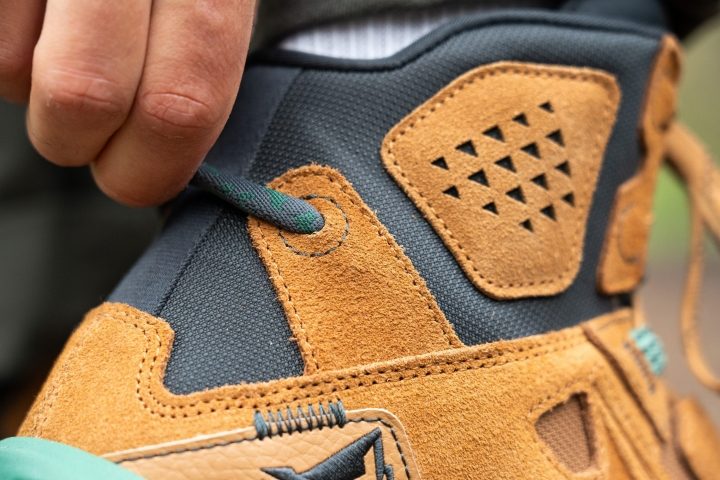
Grip and lug thickness: don’t slip!
In hiking, traction is a priority. The boot can fit perfectly but if you choose boots for dry hard-packed trails and end up covering dozens of miles in the mud, you won’t be happy and maybe not even standing due to all the slipping.
In our lab, we use a digital calliper to measure the thickness of the lugs.
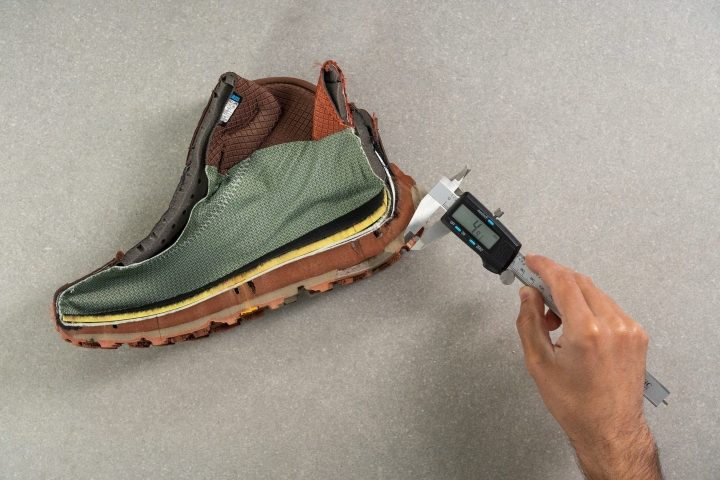
Using a digital calliper to measure the depth of the lugs in hiking boots
The deeper the lugs, the better the grip. This especially applies when it comes to soft ground like mud, slush, snow. Here are our general guidelines:
- Choose very deep lugs (4mm and deeper) if you plan to hike mainly on wet soft ground (snow, mud, slush).
- Chose average lugs (~4 mm thick) if you plan to cover a little bit of everything when hiking - maybe it will be wet, dry, soft, hard.
- Choose shallower lugs (less than 4 mm) if you plan to stick to hard-packed trails or rocky terrain.
It’s important to note that the hardness of the rubber also plays a role in traction. Generally, softer rubbers are stickier and more pliable while harder rubber outsoles offer more protection and durability.
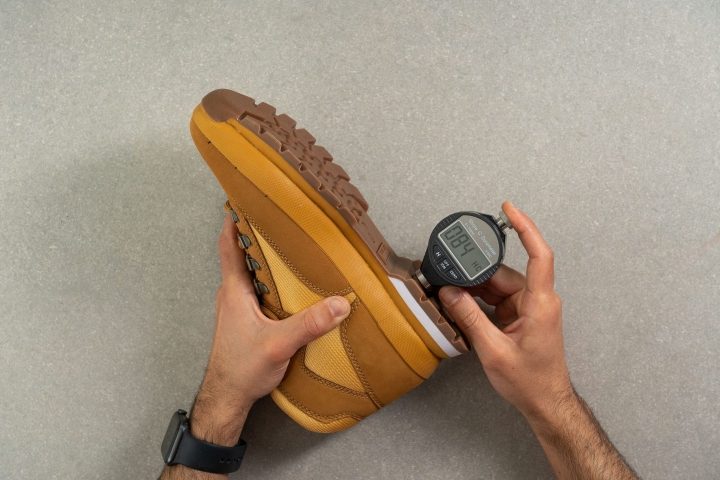
Measuring the hardness of the rubber in hiking boots using an HC durometer
We measure the hardness of the rubber with a shore C durometer. The higher the number, the harder the rubber.
Stability in hiking boots: 3 tests we do
Feeling planted when hiking, especially on uneven terrain, is imperative. Hikers who prioritise stability do not enjoy narrow and high platforms.
When doing test hikes, we always check for lateral stability. Is it easy to twist the ankle? Is it easy to bring the shoe out of the balance? See on the video below how that looks like.
Doing the lateral stability test on our wear tests

Using a digital calliper to measure the width of the base in hiking boots (up: at the heel, down: at the forefoot)
We take this a step further: we also measure the width of the base (midsole). The wider the base, the more stable the hiking shoe is.
Additionally, we measure the stiffness of the heel counter.
Flexible ones allow more ankle movement and stiffer ones, especially when the laces are tightened properly, secure the ankle to a high degree which helps with the overall stability of the shoe.
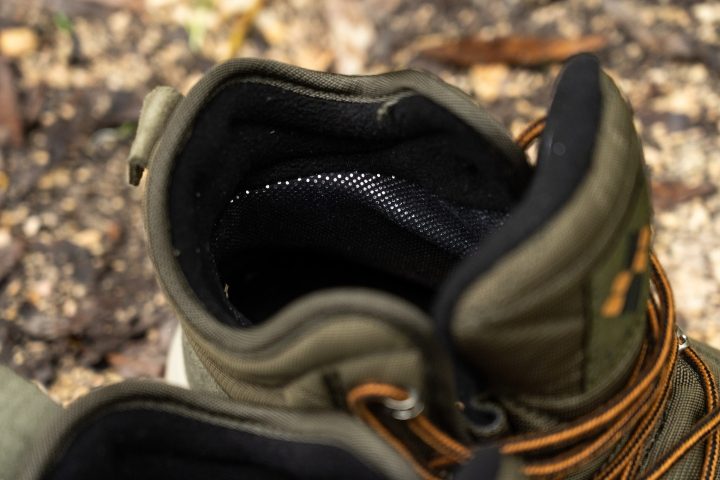
Hiking in summer: prioritise breathability!
We don’t just perform wear tests but we also do lab tests. This is especially important in breathability because feet sweat differently but our tests are standardised and every hiking boot is treated the same way in the lab.
Testing the breathability of hiking boots in RunRepeat lab
We make smoke with a smoke machine and pump that smoke into the shoe. Then, we watch where the smoke comes out and at which pace. This allows us to rate the breathability of the hiking boot on a 1-5 scale. 5 means the hiking boot is perfect for summer, as breezy as it gets! 4 as well. Such breathable shoes are never waterproof which is great because waterproof membranes are not needed in summer.
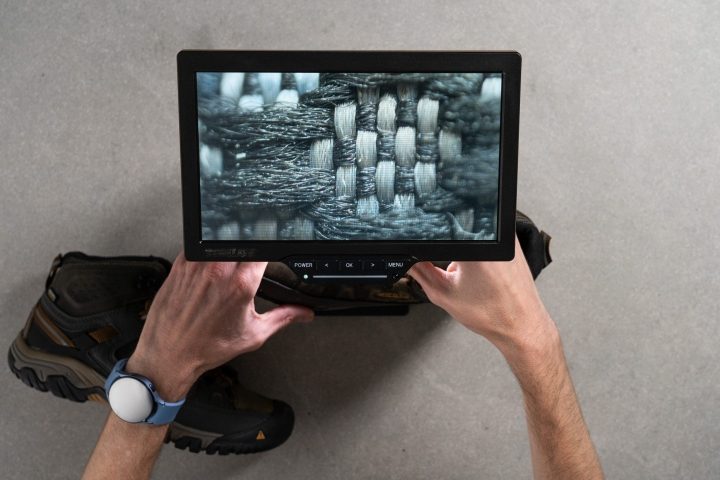
It’s very interesting to look at the uppers under a microscope and notice how waterproof hiking boots have uppers that are tightly woven and have absolutely no ventilation holes, while breathable hiking boots have uppers that are more loose.
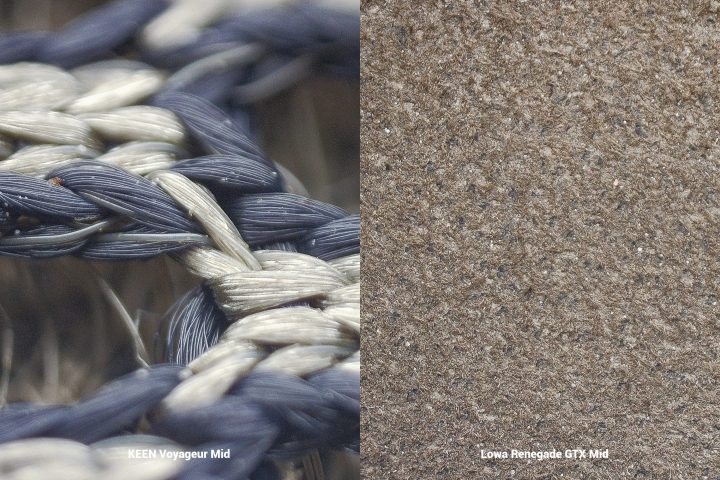
Under the microscope: Breathable vs non-breathable (waterproof) upper in hiking boots
Winter hiking boots: what to look for?
For winter hiking boots, we highlight 3 features: waterproofness, warmth and grip that works on wet ground. But, we also emphasise our freezer test which allows us to test flexibility of the boots once they've been exposed to cold weather. Will the boot feel like a brick or almost identical to how it feels at room temperatures? We answer these questions!
When it comes to waterproofness, it is best to look for waterproof membranes.
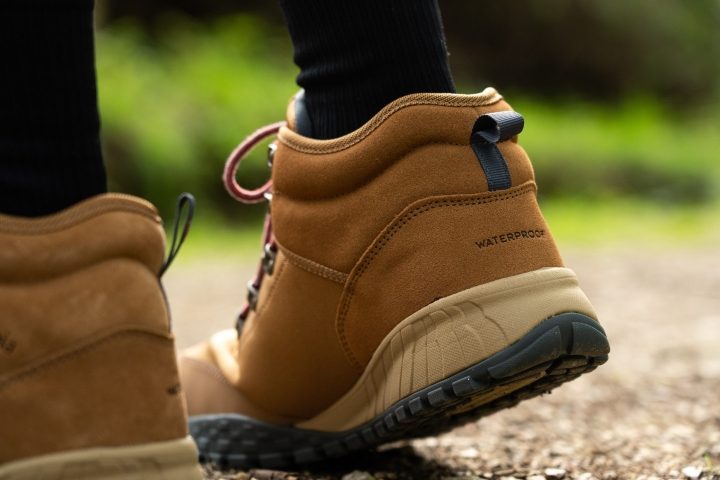
The most common one is Gore-Tex but some brands have their own trademarked membranes. The good thing is that waterproof hiking boots are horribly rated on the breathability test which means they are warmer.

Waterproof hiking boots are rated with 1 or 2 on our breathability test, meaning they are the least breathable. If you are worried about very cold weather, also look for insulation in the hiking boots.
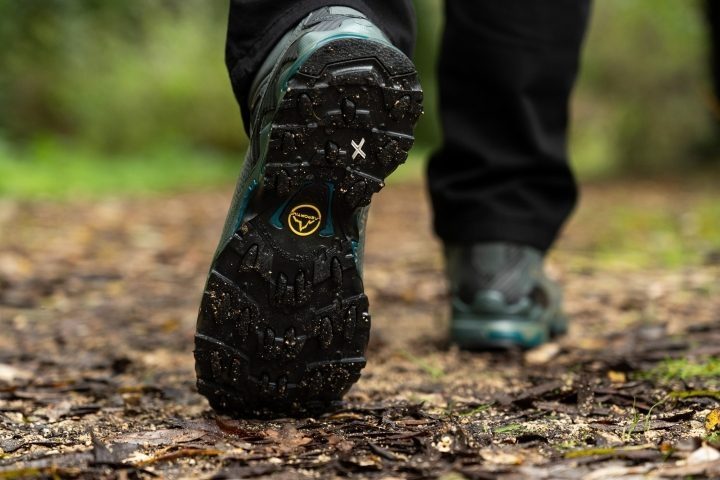
When it comes to the grip for winter hiking, we recommend deep lugs because winter usually means snow, slush or mud. When we say deep, we mean at least 4mm. No worries there, because our calliper measurements are already done and at your service.
It’s also great when hiking boots are super stable, this means that the base is wider than the upper and that the heel collar is rather stiff as covered in the section on stability.
To determine how the boot performs in winter, we put it in the freezer for 20 mins.
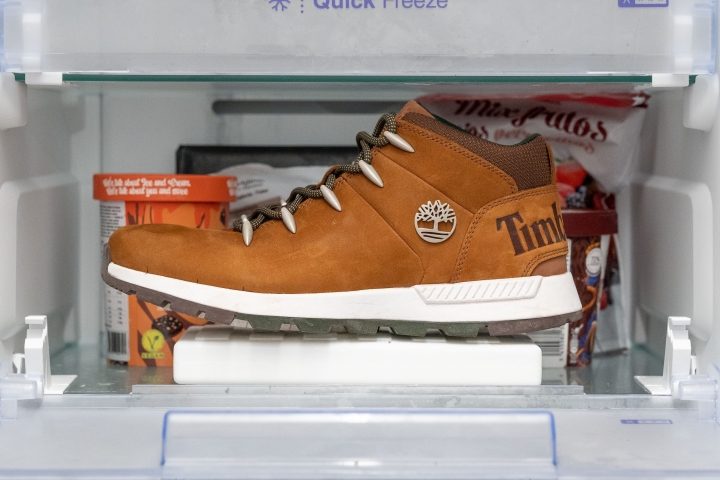
Then, we repeat the a) flexibility test, and b) midsole softness test. This tells us how much the boot stiffens up and firms up in cold weather. See below the hiking boots sorted by the smallest change in flexibility.
Harsh terrain asks for the highest durability
If you know you will hike over very harsh terrain and you want hiking boots that are super protective, we recommend looking for the most durable boots. In our lab tests, durability is assessed based on how much damage we’re able to make on 3 different parts of the boot.
Doing the Dremel test on the toebox of hiking boots
We make this damage using a Dremel. All our tests are standardised, so we always use a) the same RPM, b) the same pressure, and c) the same period of time (how much the test lasts). When we make a dent on the toe box or on the heel counter, we assess the damage on a 1-5 scale, where 1 is the least durable.
Doing the durability test on the heel counter in RunRepeat lab
However, when we press the Dremel against the outsole, we’re able to use the tyre tread gauge and to measure exactly how deep the dent is.
Testing the durability of the outsole in hiking boots with a Dremel
The deeper the dent, the less durable the outsole rubber!
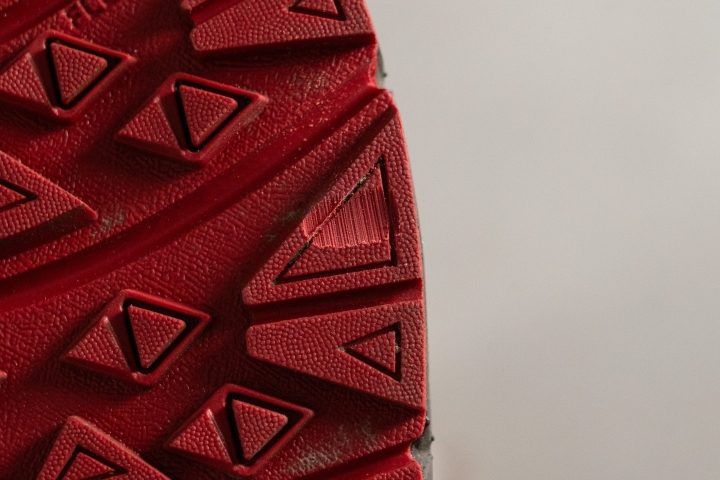
The dent on the outsole made by the Dremel during the durability test in RunRepeat lab
Lightweight vs. heavy hiking boots
We consider hiking boots lightweight when they weigh less than 17.6 oz or 500g.

We measure every boot that comes into our lab on the same scale and in men’s size 9 (US).
Heavy hiking boots are heavier because they usually offer more protection, stability, and are able to endure more abuse. We recommend using heavy hiking boots on more demanding endeavours.
Lightweight hiking boots are better for easier routes, when you don’t need as much stability, or when you plan to do fast and light hiking. This means light backpack, light boots and covering the ground at a rather higher pace.
Waterproof hiking boots: what, when and why
Use waterproof hiking boots when you know you’ll spend time in wet weather, rain, snow.
Hiking in waterproof boots (Salomon X Ultra GTX Mid)
Don’t use them for dry and warm weather because they don’t breathe well (or almost at all) and because they are pricier: you will be paying extra for something you don’t even need.
If in doubt, you can always opt for water resistant or water repellent - they might work for light rain or morning dew. Here’s how the 3 are different:
| Water-resistant | Water-repellent | Waterproof | |
| General characteristics | a tightly woven fabric that is naturally capable of resisting water upon contact | fabric treated with durable water-repellent (DWR) or hydrophobic chemicals | -fabric treated with DWR -have waterproofing membranes like Gore-Tex and OutDry -have seam-sealed construction for extra protection |
| Water protection level | low water protection | moderate water protection | high water protection |
| Water pressure resistance | 0-5000 mm (no pressure or moisture) | 6000-10000 mm (light pressure) | 10000-20000 mm (high to very high pressure) |
| Weather conditions best used in | light rain shower and dry snow | light rain and average snow | moderate to heavy rain and average to wet snow |
Another thing worth noting is the tongue gusset. When the tongue is fully gusseted, it is connected to the sides of the boot under the eyelets. This additionally prevents water/snow/debris from getting into the boot.

When tongue is "free", meaning it has no gussets and no connection to the sides, it is more likely the debris and other things will get inside the boot.
Wide-feet friendly hiking boots
We all know the struggle when you have wide(r) feet and don’t know whether the boots are wide enough for you. Fortunately, in our lab we use a digital calliper to measure the width of the upper at the forefoot.
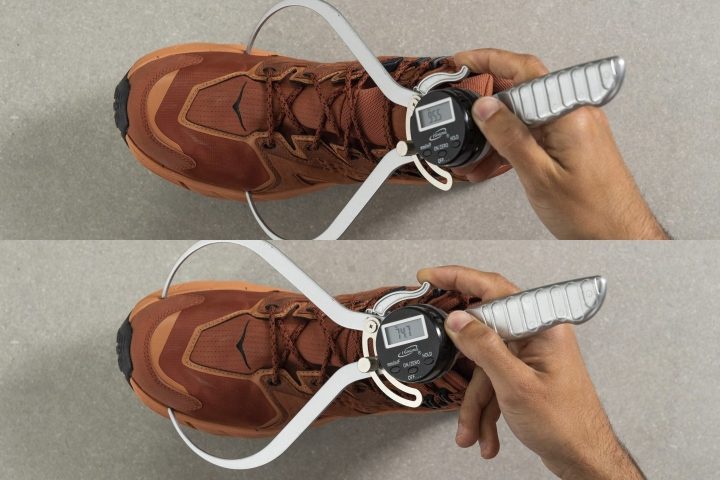
We do this in 2 places: where the forefoot is widest and around the big toe.
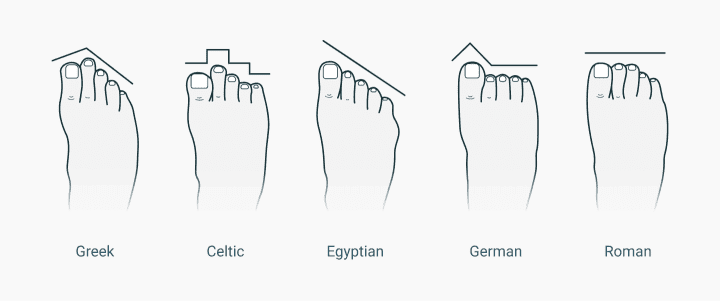
This allows us to assess how much the toe box tapers, is it pointy to accommodate Greek style better or is it wider so that other types of toes can enjoy it.
Bonus tips: 3 important features to look for in hiking boots
If you’re very much into hiking, here are 3 more things you should pay attention to when it comes to hiking boots:
- Are your hiking boots crampon compatible? This will matter once the terrain asks for crampons - usually when it is very icy and snowy. Usually, mountaineering boots are crampon compatible. This compatibility is usually given by the manufacturer. Boots can be B1, B2 or B3 graded and, therefore, compatible with C1, C2 or C3 crampons.
- Is the lining/insole antimicrobial? Very important if you have sweaty feet. Check the specifications from the brand to find out.
- Can your boots be resoled? This is up to the manufacturer, so check with them. It’s convenient because such shoes can then last longer, as long as the upper is not damaged.
Get noticed in the dark!
Some hiking boots come with reflective elements that make them noticeable in the dark. If this is a feature you find important, make sure to look for it. In all our hiking boot reviews we make sure to note whether the shoe has them or not.
See here how Keen Targhee III Waterproof Mid shines in the dark
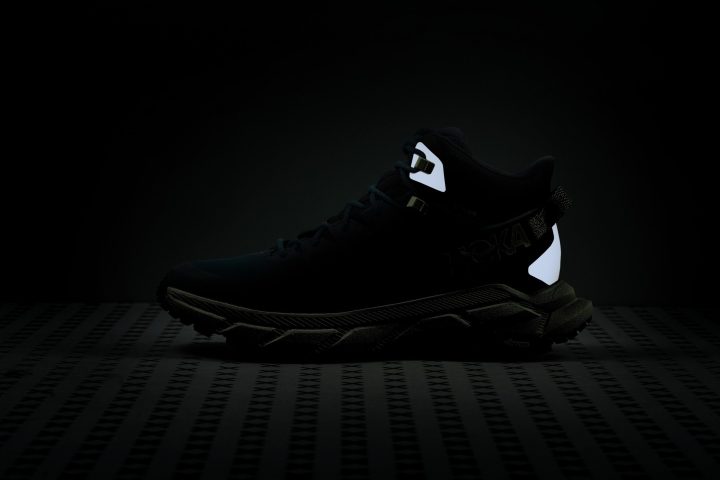
Above, you can see the reflective elements on Hoka Trail Code GTX.

